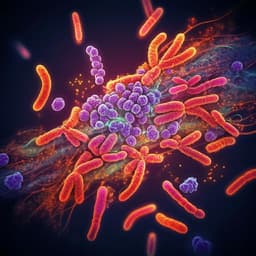
Agriculture
Diversity in susceptibility reactions of winter wheat genotypes to obligate pathogens under fluctuating climatic conditions
R. Jevtić, V. Župunski, et al.
This study by Radivoje Jevtić and colleagues delves into the intriguing dynamics between powdery mildew and rusts in wheat. By analyzing over 2000 winter wheat genotypes, it uncovers how shifting winter temperatures and specific climatic factors affect pathogen prevalence and interactions. A fascinating coexistence of rust species is revealed, shedding light on their critical implications for wheat production.
~3 min • Beginner • English
Introduction
The impact of climate change on wheat production has become a global problem, with projections that a 1 °C increase in temperature could decrease wheat yields by about 6%. Altered climatic patterns can change distribution pathways and the predominance of key wheat pathogens, notably powdery mildew (Blumeria graminis f. sp. tritici) and rust diseases (Puccinia graminis f. sp. tritici, Puccinia triticina, Puccinia striiformis f. sp. tritici). In Serbia, leaf rust had historically been predominant, but in 2014 yellow rust predominated under changed climate conditions, reaching high disease indices and yield losses. While many efforts have modeled disease incidence and yield losses focusing on abiotic factors, the combined effects of abiotic and biotic stressors on disease occurrence are often neglected, and developing general local-scale outbreak models in the short term is unlikely. Recent work shows abiotic stresses (temperature extremes, drought, salinity) alter plant physiology and defense, with stress response networks exhibiting antagonism and prioritization, and combined stress responses cannot be predicted from single stresses, underscoring the need to treat combinations as unique conditions. Given that winter wheat genotypes can express different reactions under fluctuating climates, this study hypothesized that interactions among obligate pathogens are influenced by plant physiological responses to climatic fluctuations, and that powdery mildew and rust occurrence cannot be explained solely by pathogen life cycles and resistance/virulence genes. The objective was to analyze the combined effects of abiotic and biotic factors on prevalence of obligate pathogens in winter wheat, focusing on susceptible genotypes under extreme winter climatic fluctuations and pathogen pressure, using a high-throughput phenotyping platform of 2,158 diverse winter wheat genotypes. The study aims to improve understanding of plant–environment interactions affecting powdery mildew and rust prevalence and to inform climate-smart pest management.
Literature Review
Prior studies have quantified climate change impacts on wheat yields and quality and developed forecasting models primarily based on abiotic variables (temperature, humidity, rainfall). Work has documented that climatic shifts alter distribution and predominance of wheat diseases. Climate-smart pest management frameworks emphasize resilience but acknowledge the difficulty of predicting local, climate-driven pest outbreaks. Research on combined abiotic and biotic stresses shows plant responses are not simply additive, with regulatory networks that can be antagonistic and prioritize certain responses; thus, combined stress must be treated as a unique condition. Yellow rust and leaf rust have different climatic requirements; high winter temperatures can favor yellow rust, leading to forecasting models that often omit cultivar effects. Temperature-dependent expression of resistance genes to powdery mildew has been reported, and temperature changes can modulate defense to yellow rust independently of specific resistance genes, with additional evidence for roles of calcium-dependent phospholipid-binding proteins in responses to both pathogens and temperature. Globally, stem rust re-emergence (e.g., Ug99, TTTTF) poses significant threats despite prior control, highlighting the need to understand how climatic fluctuations and phenological shifts influence obligate pathogen prevalence.
Methodology
Field trials were conducted in a phenotyping platform for high-throughput screening of obligate pathogens (Blumeria graminis f. sp. tritici, Puccinia graminis f. sp. tritici, Puccinia triticina, Puccinia striiformis f. sp. tritici) using 2,158 winter wheat genotypes with diverse genetic backgrounds at Rimski Šančevi (Vojvodina, Serbia) from 2016 to 2019. Trials followed CIMMYT guidelines for screening nurseries: each genotype was sown under naturally occurring inoculum in one-meter rows, five replicates, 20 cm spacing (1 m² plot), with the susceptible soft wheat variety Barbee replicated across the platform to ensure uniform inoculum pressure. The mean sowing date was October 20. Assessments were made at BBCH growth stages 71–73 (kernel watery to early milk), using disease indices (DI, %) calculated as the product of disease incidence (percent plants infected per plot) and average disease severity estimated with a modified Cobb’s scale. DI was computed as DI (%) = [Σ(class frequency × rating score)] / [(total plants) × (max score)] × 100. Susceptibility classes were defined: 0–5 very resistant, 6–10 resistant, 11–29 moderately resistant, 30–40 moderately susceptible, 41–65 susceptible, >66 very susceptible. For interaction analyses among pathogens, 1,389 genotypes that were moderately to very susceptible (DI ≥30% in at least one year) were used. Rust race population structure at the site was monitored in collaboration with John Innes Centre, confirming predominance of Warrior races of yellow rust and TTTTF for stem rust (personal communication). Statistical analyses: Principal component analysis (PCA) characterized relationships among disease indices of powdery mildew and rusts per season, interpreting approximate correlations from vector angles (small: positive; 90°: none; ~180°: negative). Spearman correlations quantified pairwise relationships. Multiple linear regression (stepwise) identified factors influencing disease indices, treating genotype as a categorical variable and pathogens and climatic variables (monthly mean temperature, relative humidity, total rainfall from November to June) as continuous predictors. Meteorological data were from the Republic Hydrometeorological Service. Regression diagnostics included residual analysis, outlier checks, and normality assessment via probability plots.
Key Findings
- Disease occurrence varied non-linearly across 2016–2019. Yellow rust was prevalent in 2016 and 2018 (average DI ~31.3% and 31.5%) and near trace levels in 2017 and 2019. Powdery mildew occurred consistently with average DI 11.7–21.5% across years. Leaf rust predominated in years unfavorable for yellow rust, with average DI 13.5% (2017) and 39.8% (2019). Stem rust outbreaks occurred in 2019: 35% of genotypes showed symptoms with average stem rust DI 24.8% among infected cohorts, and 16% of genotypes had DI >25%. Overall average stem rust DI across all genotypes was 8.7% in 2019.
- Stepwise multiple regression identified genotype (P<0.001) as a significant factor for disease indices, and obligate pathogens significantly influenced each other’s disease indices (P<0.001).
- PCA across seasons showed leaf rust and yellow rust were typically negatively correlated (vectors ~180°), forming the first principal component in 2016 and 2018 (explaining 43% and 49% variance). Spearman correlations confirmed a statistically significant negative correlation between yellow rust and leaf rust in all seasons (P<0.001; low-to-moderate magnitude due to genotype diversity). Powdery mildew generally showed no correlation with rusts (vector ~90°), except in 2017 when it was positively correlated with yellow rust (Spearman r=0.29, P<0.001). In 2019, stem rust loaded with powdery mildew in the first component; Spearman showed stem rust uncorrelated with other pathogens except powdery mildew (r=0.28, P<0.001).
- Within-season inconsistencies: In 2018, among 1,989 genotypes with yellow rust symptoms, yellow rust predominated over powdery mildew in 55.5%, but powdery mildew predominated in 33% despite conditions favoring yellow rust. An analysis of 740 genotypes (leaf rust DI ≤10% in 2016 and 2018) split into two sets showed: (a) where yellow rust predominated in 2018, January temperature (P<0.001) and genotype (P<0.001) were most influential for both yellow rust and powdery mildew (R² 61% and 63%); January 2018 mean was 4.3 °C versus long-term −0.1 °C. (b) Where powdery mildew predominated in 2018, February temperature (P<0.001), yellow rust (P=0.028), and genotype (P=0.023) most influenced powdery mildew (R² 77.8%); February 2018 mean (1.2 °C) was ~7 °C below February 2016 (7.5 °C). Residual diagnostics indicated no outliers and approximate normality.
- Leaf rust versus yellow rust in 2018 (303 genotypes with powdery mildew DI ≤10% in 2016 and 2018): Although 2016 favored yellow rust over leaf rust in both sets, in 2018 leaf rust predominated in 21% of genotypes. Where leaf rust predominated, February temperature (P=0.001) and yellow rust (P<0.001) influenced leaf rust DI (R² 86%). Where yellow rust predominated, January temperature (P<0.001) was the most influential factor for both pathogens, mirroring the powdery mildew versus yellow rust result.
- Stem rust as a hidden threat: In 2019, severe autumn and winter rainfall deficits delayed emergence and phenology, predisposing to stem rust outbreaks. Multiple regression identified November precipitation (P<0.001), leaf rust (P=0.007), and powdery mildew (P=0.001) as influencing stem rust DI (R² 51.4%). Stem rust coexisted with powdery mildew and leaf rust; correlations were low (stem rust vs powdery mildew r=0.28; no correlation with leaf rust), consistent with co-expression on different organs.
- Overall, genotype-by-environment interactions and winter temperature fluctuations (January vs February warmth) critically modulated pathogen predominance, sometimes allowing powdery mildew or leaf rust to predominate over the typically more aggressive yellow rust.
Discussion
Findings demonstrate that interactions among rust species and powdery mildew are seasonally contingent and shaped by both climatic precursors and genotype-specific responses, rather than by abiotic conditions alone or simple pathogen life-cycle considerations. Powdery mildew persisted annually, and in 2018 it predominated over yellow rust in a substantial subset of genotypes under conditions otherwise favorable to yellow rust, highlighting temperature-dependent resistance expression and genotype-specific physiological responses to winter temperature fluctuations. The persistent negative association between yellow rust and leaf rust aligns with their differing climatic requirements, yet a notable fraction of genotypes showed leaf rust predominance in 2018, underscoring the importance of including cultivar effects in forecasting models that traditionally emphasize winter temperature thresholds for yellow rust. The timing of winter warmth (January vs February) emerged as a critical determinant: warmer February conditions favored broader yellow rust predominance, whereas disparate monthly patterns altered genotype responses and shifted pathogen dominance. The 2019 stem rust outbreak illustrates how drought-induced delays in early phenophases can re-open windows for stem rust infection, with November rainfall deficits serving as a key environmental trigger. Low correlations among stem rust and other pathogens suggest coexistence rather than mutual exclusion, partly due to infection of different organs, while modest influences of powdery mildew and leaf rust on stem rust point to complex multi-pathogen interactions. Collectively, the results emphasize that combined abiotic and biotic stresses act as unique conditions, and genotype × environment interactions can reverse expected pathogen hierarchies, complicating prediction and management under climate variability.
Conclusion
Serbia experienced pronounced interannual fluctuations in winter temperatures (January −5 to +5 °C; February 1.2 to 7.5 °C) and rainfall (November 24.6–67.1 mm; February 18–81 mm) during the study period. This work highlights that combined abiotic and biotic stresses, and particularly genotype-specific responses to winter climatic fluctuations, strongly influence the prevalence and interactions of wheat obligate pathogens. Winter temperature fluctuations in early developmental phases can shift pathogen predominance among susceptible genotypes, undermining the reliability of disease prevalence forecasts. Combined stresses should be treated as unique conditions to develop effective climate-smart pest management. Understanding mechanisms by which climatic elements modulate pathogen–host interactions is essential to advance integrated pest management and sustain wheat production under changing climates.
Limitations
Related Publications
Explore these studies to deepen your understanding of the subject.







